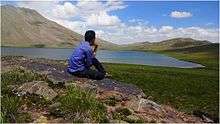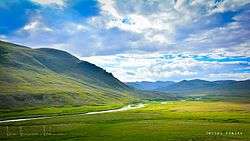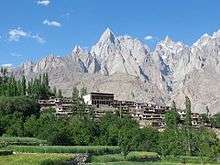Deosai National Park
| Deosai National Park | |
|---|---|
| Ghbyarsa "غبیارسہ " | |
|
The blooming Deosai Plains, Deosai National Park. | |
| Location | Skardu Gilgit Baltistan Pakistan |
| Nearest city | Skardu |
| Coordinates | 34°58′N 75°24′E / 34.967°N 75.400°ECoordinates: 34°58′N 75°24′E / 34.967°N 75.400°E |
| Area | 3,000 km2 (1,200 sq mi) |
| Established | 1993 |
| Governing body | Directorate of Deosai National Park Sadpara Road, Skardu |
The Deosai National Park is located in between Skardu, Gultari, Kharmang and Astore Valley, in the Gilgit-Baltistan region of Northern Pakistan, majority of which falls in Skardu district.[1]
Etymology

In Urdu, Deosai Urdu "دیوسای٘" means 'the land of Giants'. It is locally called غبیارسہ Ghbiarsa referring to "Summer's Place" by Balti people because it is only accessible in summer.
Geography
Deosai National Park falls in Skardu Baltistan and has an average elevation of 4,114 metres (13,497 ft) above sea level, making the Deosai Plains one of the highest plateaus in the world. The park protects an area of 3,000 square kilometres (1,200 sq mi). It is well known for its rich flora and fauna of the Karakoram-West Tibetan Plateau alpine steppe eco region. In spring, it is covered by sweeps of wildflowers and a wide variety of butterflies. Deosai is second highest plateau after Chang Thang Plateau Tibet.
Geology and Soil
The soils of this area are severely eroded, of a coarser nature and mixed with gravel and stones of various material and sizes. In flat areas between mountains, soil is deep with marshy vegetation.
How to reach there
Deosai is accessible from Skardu District in the north, Gultari Kharmang district in the south-east, and the Astore District in the west. Deosai is located approximately 30 km from Skardu city and it is the shortest route to visit Deosai. Most foreigners visit deosai via Skardu. It takes 1 hour to reach Deosai top via Sadpara Skardu. Another route is from Astore valley via Chilim. It is also accessible from Shila valley. The people of Gultari travel via Deosai. There is another route called Burgi la via Tsoq Kachura valley Skardu.
Sheosar Lake
Deosai Lake, or Sheosar Lake from the [] meaning "Blind lake" (Sheo - Blind, Sar - lake) is in the park. The lake, at an elevation of 4,142 metres (13,589 ft), is one of the highest lakes in the world. Its length is 2.3 kilometres (7,500 ft), width 1.8 kilometres (5,900 ft) and average depth 40 metres (130 ft).
Fauna and Flora
The Deosai National Park was established in 1993 to protect the survival of the Himalayan brown bear and its habitat. Having long been a prize kill for poachers and hunters, the bear now has a hope for survival in Deosai where its number has increased from only 19 in 1993 to 40 in 2005. During the last decade, a few but effective measures have been taken by the Government of Pakistan for the survival of brown bear in the region. In 1993, Himalayan Wildlife Project was founded with a substantial financial support from international environmental concerns. But the brown bear is still under threat.
The Deosai Plains are also home to the Himalayan ibex, red fox, golden marmot locally called Phia, gray wolf, the Ladakh urial, the snow leopard, and over 124 resident and migratory birds. Birds in the park include the golden eagle, lammergeier, griffon vulture, laggar falcon, peregrine falcon, kestrel, sparrowhawk and snowcock. The following species are found in Deosai Artemisia maritima, Polygonum affine, Thalictrum alpinum, Bromus oxyodon, Saxifraga flagellaris, Androsace mucronifolia, Aster flaccidus, Barbarea vulgaris, Artemisia maritima, Agropyron longearistatum, Nepeta connate, Carex cruenta, Ranaculyus laetus, Arenaria neelgerrensis, Astrogalus leucophylla, Polygonum amplexinade, Echinop nivetus, Seria chrysanthenoides, Artemisia maritima, Dracocephalum nutsus, Anapalas contorta, Chrysopogon echinulatus, and Dianthus crinitus. There were also observed some medicinal plants which are locally famous i.e. Thymu linearis (Reetumburuk), Saussures lappa (kuth), Ephedra intimedia (Say), Viola canescens (Skora-mindoq), Dracocephalum muristanicum (Shamdun) and Artemisia maritima (Bursay) etc. are used as traditional drug therapies.
Cultural references
Herodotus
Research by the French ethnologist Michel Peissel makes a claim that the story of 'Gold-digging ants' reported by the Greek historian Herodotus, who lived in the 5th century BC, was founded on the golden Himalayan Marmot of the Deosai plateau and the habit of local tribes such as the Minaro to collect the gold dust excavated from their burrows.[2]
In film
The documentary film series Land of the Tiger, in episode 5 - the "Mountains of the Gods", features the plants and animals of Deosai. Karakoram Heli skying 2013 by Walkabout Films. Documentary movie "Deosai the last sanctuary"
Gallery
 Sign Board at Deosai National Park, Skardu
Sign Board at Deosai National Park, Skardu Entrance of Deosai National Park, Skardu
Entrance of Deosai National Park, Skardu Tourist information map of Deosai National Park
Tourist information map of Deosai National Park A mix of Green plains, Mountains and Waters. The never ending Deosai Plains
A mix of Green plains, Mountains and Waters. The never ending Deosai Plains The "Endless Plains" of Deosai National Park
The "Endless Plains" of Deosai National Park Deosai Lake and the Deosai Plains, Deosai National Park
Deosai Lake and the Deosai Plains, Deosai National Park Deosai Nation Park in August
Deosai Nation Park in August Deosai National Park
Deosai National Park
See also
https://www.facebook.com/Deosai-National-Park-Skardu-415640568645757/
| Wikimedia Commons has media related to Deosai National Park. |
References
| Wikivoyage has a travel guide for Deosai National Park. |
- ↑ Deosai, National Park. "Deosai National Park 2nd Highest Plateau in the World". www.skardu.pk. Skardu.pk. Retrieved 23 November 2016.
- ↑ Peissel, Michel. "The Ants' Gold: The Discovery of the Greek El Dorado in the Himalayas". Collins, 1984. ISBN 978-0-00-272514-9.

